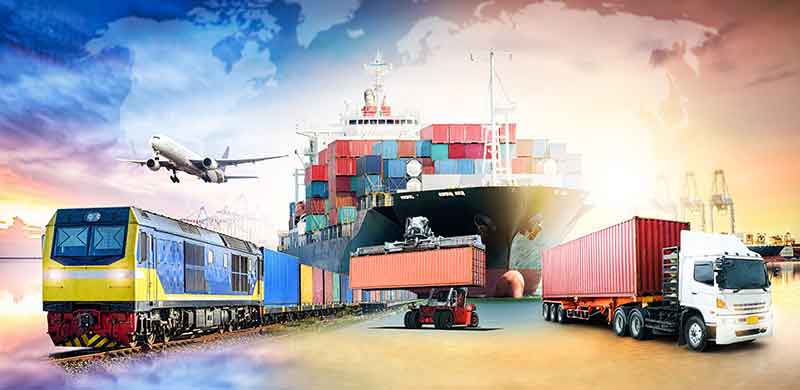Container shipping is the backbone of international trade, with approximately 90% of goods transported by it. In today’s guide, we will delve into the world of container shipping, covering its definition, how it works, and everything you should know.
Table Of Contents
- What is container shipping?
- What are the types of cargo containers?
- What is the size of a shipping container?
- How does container shipping work?
- What is the cost of a shipping container?
- What is the shipping documentation you need?
- How to track a shipping container?
- How to prepare for container shipment?
- How can ASL help you in container shipping?
What is container shipping?
It generally uses large, strongly built steel shipping containers to transport cargo internationally. These containers are specially designed to fit securely on cargo ships, trucks, and trains, allowing seamless intermodal transportation.
Containerized shipping enables carriers to deliver containers without touching the cargo inside. It greatly reduces the potential for damage or loss during transportation.
Here are two primary container shipment modes: FCL (Full Container Load) and LCL (Less than Container Load).
FCL: For enough goods to fill an entire container. It is the most secure option and can prevent contamination or damage to your cargo from other shippers’ cargo.
LCL: For shipping small quantities of goods or break-bulk cargo. It is more economical to share a container with other shippers rather than booking an entire container for yourself.
What are the types of cargo containers?
Below, we have collected some different types of shipping containers you can use based on your cargo needs:
1. Standard dry cargo container
These are the most common general-purpose containers for shipping cargo. Besides, standard dry van containers are airtight and protect cargo from wind, moisture, and dust.
2. Refrigerated cargo containers
Reefers containers aim to transport goods that require temperature control, such as fruits, vegetables, pharmaceuticals, and frozen products. They maintain a specific temperature range to preserve the cargo’s freshness.
3. High cube containers
High cube containers are taller (around 2.8m or 9’6″) than standard ones, providing extra vertical space. They are suitable for goods that require additional height, such as furniture or oversized machinery.

4. Open-top containers
Open-top containers are almost identical to dry cargo containers but feature removable roofs. You can consider it if your goods have a larger volume than general containers but are not big enough for a high cube container.
5. Flat rack shipping containers
Flat-rack containers have no two long sides, making them suitable for oversized cargo, heavy machinery, or project logistics that cannot fit properly into a general cargo container.
6. Flexitank containers
Tank containers help to ship non-hazardous liquids or gases like chemicals, water, or cooking oil. Typically, a flexitank container can hold about 10,000 – 24,000 liters of liquid cargo. They have cylindrical tank compartments and are equipped with safety features.
7. Insulated containers
Insulated containers, also called non-operated reefer containers, maintain a consistent temperature. They are ideal for goods that require temperature control but are not as critical as perishables. Examples include pharmaceutical products or chemicals.
8. Open-side container
It is one of the special-purpose containers with doors on one or both sides. These boxes allow easy access to the cargo from multiple directions. They are beneficial for goods that need frequent access or loading from the side.
An appropriate container is critical to ensure safe and efficient cargo shipping. At Airsupply, we have integrated with a container marketplace where you can start container shipping in over 1,000 locations worldwide. It allows us to book slots on vessels in time for you according to your freight requirements.
What is the size of a shipping container?
Shipping containers come in various sizes to accommodate different types of cargo. The two most common sizes are Twenty-Foot Equivalent Units (TEU) and Forty-Foot Equivalent Units (FEU). However, other sizes for container shipping, such as 10-foot and 45-foot are also available.
Here are the detailed external and internal container dimensions that you can refer to maximize your cargo space utilization:
1. 10-foot container dimensions
| External | Internal | |
|---|---|---|
| Length | 10 feet (3.05 meters) | 9 feet 5 inches (2.87 meters) |
| Width | 8 feet (2.44 meters) | 7 feet 8 inches (2.33 meters) |
| Height | 8 feet 6 inches (2.59 meters) | 7 feet 10 inches (2.38 meters) |
These containers are not mainstream in international shipping trade in sea freight. But they often can be used for shipment storage or land shipping like truck transporting to limited areas.
2. 20-foot standard container
| External | Internal | |
|---|---|---|
| Length | 20 feet (6.1 meters) | 19 feet 4 inches (5.89 meters) |
| Width | 8 feet (2.44 meters) | 7 feet 8 inches (2.35 meters) |
| Height | 8 feet 6 inches (2.59 meters) | 7 feet 9.5 inches (2.38 meters) |
For example, A TEU container can accommodate about 1 to 2 small-sized automobiles, such as sedans or compact cars. Meanwhile, it also can fit 10-11 standard pallets with a payload of about 24,000 pounds (10,886 kilograms) or 11 metric tons.
3. 40-foot standard container
| External | Internal | |
|---|---|---|
| Length | 40 feet (12.19 meters) | 39 feet 5.7 inches (12.03 meters) |
| Width | 8 feet (2.44 meters) | 7 feet 8.5 inches (2.35 meters) |
| Height | 8 feet 6 inches (2.59 meters) | 7 feet 10.3 inches (2.39 meters) |
A standard FEU container can hold around 20 to 24 pallets. It is preferred for container shipping high-volume cargo in ocean freight.
How to identify the right container size for my shipment?
To select the suitable shipping container for your cargo, assess the type of your goods while considering the weight and volume.
Keep in mind that there are specialized containers for specific cargo types, such as open-top containers for oversized cargo and flat-rack containers for irregularly shaped items.
If you’re uncertain which one should choose, consult our shipping experts. At Airsupply, we can help you determine the best shipping container size and customize cost-effective solutions for your container shipping.
How does container shipping work?
Container shipment is a complex process involving many players and lots of handling parts. Take a closer look at the container shipping process:
1. Pick a shipping container and determine the mode (LCL or FCL) based on your shipment needs.
2. The carrier will transport the loaded containers to the nearest port, often by truck or drayage shipping.
3. At the port, containers are stored in designated areas after final checking while data recording and awaiting loading onto the vessel.
4. Leverage large cranes and other equipment to load containers onto the vessel.
5. During the voyage, the crews will securely store the containers on the ship’s deck and within its holds to withstand the rigors of the open sea.
6. Upon arrival at the destination port, the vessel is unloaded. Containers are carefully removed from the ship and placed on the dock.
7. Goods should go through customs clearance procedures, including inspections, documentation checks, duties, and tax assessments.
8. After clearing customs, containers are transported to their final destination, often by truck or train.
9. At the final destination, unloaded from the containers. The cargo is then distributed to its recipients or transported to retail stores or warehouses.
10. The shipping company will return the empty containers to the specific container yard, waiting for the next booking.
Typically, an importer will order from suppliers and hire a freight forwarder to ship the goods. We at Airsupply can handle all procedures from shipping to customs clearance, ensuring you can receive the container hassle-free.
What is the cost of a shipping container?
For many importers, booking a container for a one-way shipment makes the most sense. It involves leasing a container for a specific period, which is often more cost-effective than purchasing one.
Let us take a look at one-time transporting fees for shipping containers on some popular routes:
Average shipping prices from China to the UK:
20-foot Container (FCL): Approximately $1,000 to $2,000
40-foot Container (FCL): Approximately $1,800 to $3,500
Estimated shipping rates from China to the USA:
20-foot Container (FCL): Around $1,200 to $2,500 (West Coast) / $1,500 to $3,000 (East Coast)
40-foot Container (FCL): Around $2,000 to $4,000 (West Coast) / $2,500 to $5,000 (East Coast)/p>
However, the freight container shipping cost can vary significantly based on several factors, including the type, condition, size, and distance. Generally, the larger the container and the further the destination, the higher the price.
You can send us your shipping requirements. As booking with the ship owners first-hand, we can provide the best-personalized logistics solution at a competitive price.
What is container shipping documentation?
In order to make your container shipping comply with regulations and pass customs smoothly, you should offer the necessary documents. These documents include the bill of lading, which the receiver uses to pick up the goods indispensable.
Another critical document is the freight bill, serving as an invoice for shipping costs from point A to B. Other documents encompass a commercial invoice, certificate of origin, packing list, and more. You can access the complete list of required shipping documents here.
How to track a shipping container?
Containers undergo a long journey from their origin to the final destination. Numerous unforeseen circumstances can lead to delays in shipments along the way.
Therefore, it is significant to keep track of your container shipping so that you can address any issues promptly and preempt postponement.
Once you work with Airsupply, tracking your containers becomes effortless. You can say goodbye to spending hours on the phone or struggling with complex shipping line websites.
With our advanced tracking system, you can monitor your container’s location at any time. Additionally, our system provides visibility into which containers are arriving on schedule and which will experience delays.
How to prepare for container shipment?
So, what do you need to do before container shipping? Below are some considerations you should keep in mind:
Properly packing
Use appropriate packaging materials, padding, and bracing to safeguard your cargo. Make sure that your packaging is lightweight and does not add too much bulk to your overall container load, as this will make your shipment more expensive.
Container inspection
Conduct a thorough inspection of the container before loading your cargo. Ensure the box is clean, free from pests or contaminants, and in good condition. Take photos if necessary for documentation.
Secure your cargo inside the container
Make your items tightly packed, with heavier cargo placed at the bottom. Furthermore, distribute your shipment weight evenly within the container to maintain stability during transit. Overloading one end or side can lead to safety hazards and damage.
Sealing the container
Always use a high-quality container seal on your box. Otherwise, you expose your container to the risk of tampering, potentially resulting in theft or damage to your goods. Additionally, don’t forget to document the seal number for tracking purposes.
Booking with a shipping line
Book your container space with a reputable freight forwarder. Confirm vessel schedules, transit times, and any additional services required.
How can ASL help you in container shipping?
Airsupply boasts a wealth of expertise in container shipping and logistics. Whether air, sea, truck, or railway transport, they can guarantee enough cargo space and smooth container delivery.
Meanwhile, Airsupply can handle cargo consolidation or LCL shipping with the best freight rates. By working with their dedicated team, you can be free from the intricacies of customs regulations and supply chain management.




